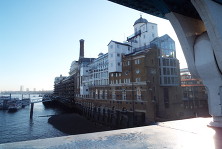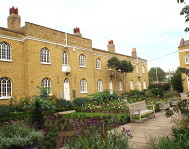








Octavia Hill in Walworth
At the very beginning of the 20th century, an area of 22 acres to the east of Walworth Road that centred around Portland Street reverted to the Ecclesiastical Commissioners having previously been let on long leases. These had been granted 200 years previously by the Dean and Chapter of Canterbury and during this time, leaseholders and often sub-leaseholders had built small, shoddy and sub-standard houses where only the poor would live. The Ecclesiastical Commissioners found themselves to be slum landlords by default when the land returned to their sole possession.
From Charles Booth's Poverty Maps of 1898. Light Blue indicates areas where inhabitants were classed as Poor and dark blue areas where inhabitants were Very Poor.
The 1898 Booth Poverty Maps show, whilst Portland Street itself were regarded as a mixed area where both poor and those more comfortable lived, there was an area to the east of Portland Street, behind St Peter’s Church, that was classed as Poor and a few streets that were regarded as Very Poor. The streets this area centred around were then called Shaftesbury Street, Dewhurst Street, Bretell Street, Clandon Street, Burton Street and Webb Street. The Ecclesiastical Commissioners decided, perhaps in part prompted by the local Browning Hall Settlement, to demolish the existing poor
housing and to redevelop the site at an estimated cost of £200,000. They worked with housing reformer Octavia Hill who not only already managed many of the Church’s properties in London but had also built new housing for the poor, including 4 small developments in the Borough.
Octavia Hill was an extraordinary woman of high energy and high ideals. She managed and developed many housing projects for the poor, and in addition to her housing reform work, was an advocate for open spaces and a co-founder of the National Trust in 1895. Her approach was holistic in that she believed that moral reform and education of the individual went hand in hand with housing reform and that it was necessary for the character of the poor to improve for a lasting solution to the housing problem. To this end she had a network of ‘fellow workers’ who visited the tenants in their dwellings and apart from collecting the rent would be on hand with advice regarding improvements to their home, cleaning and budgeting. She also accepted tenants from a lower classes and those in more casual employment who were excluded by the other organizations. Like other organizations, if rent was not paid or if the tenants were intemperate, they were evicted. She was against large blocks as they were ugly, did not allow for individuality and led to behaviour problems, believing that housing should be developed on a small scale on the pattern of houses and cottages. Neither did she agree with mass slum clearance, believing a programme of refurbishment and patching was preferable.
In the case of the Walworth estate, the existing houses were in far too great a state of disrepair to renovate and patch. Under Octavia’s influence, the Commissioners concentrated on building a combination of cottages with individual rear back gardens and tenement blocks that had a maximum height of three storeys and two apartments per floor. Great care was taken to use as much natural light as possible and land set aside for a recreation area which became Faraday Gardens. Established trees and shrubs were conserved as much as possible, roads were widened and the road layout altered. The Ecclesiastical Commissioners forbade the inclusion of any public houses. The logistics were complicated as families were moved out of the houses due to be demolished, rehoused in temporary accommodation, then moved again into newly built cottages or tenements.
By 1907, modern housing had been built to accommodate 790 families in a mix of 4- and 3-roomed cottages, and 3- and 2-roomed flats in tenement blocks. Octavia described the opening of Faraday Gardens a year earlier:
“I had a wonderful day yesterday. The LCC opened the garden given by the Ecclesiastical Commissioners at Walworth. The whole place gay; a platform at one end was enclosed, but in front of us was the whole space crowded with people, the garden being open to all. In front and around were all new houses, with large bow-windows overlooking the garden, wider streets, the whole 22 acres either rebuilt or rebuilding.”
Faraday Gardens with St Peter's in the background. This part of the park was created after the second world war when half of Trafalgar Street was cleared.
The Ecclesiastical Commissioners let and managed the estate for 100 years and charged rents in line with other social housing organisations. Then, in 2006 they sold the Walworth Estate along with four other London estates to a partnership formed between a private residential property owner and a housing association. Extraordinarily the Church Commissioners claimed they were not “focused housing providers” and because the housing association were better able to invest for the future, it would be a better outcome for the tenants. Despite protests from within the Church, tenants, local MPs and the Mayor of London that this could lead to a very real possibility that the estates could fall into private ownership and mean higher rents for tenants, the sale went ahead. The Church Commissioners maintained that it was their role to seek the best price for their assets rather than take into account pastoral or social considerations. Clearly they listen more to lawyers and accountants than their conscience.
In 2011 it was announced that Grainger PLC, the private property company, were now the sole owner of the properties.
Web discoveries
- UK Casino Not On Gamstop
- UK Casino Not On Gamstop
- Non Gamstop Casino
- Casinos Not On Gamstop
- Non Gamstop Casinos
- Non Gamstop Casinos
- Non Gamstop Casino
- Casino Sites Not On Gamstop
- Slots Not On Gamstop
- Casinos Not On Gamstop
- UK Betting Sites Not On Gamstop
- UK Casino Not On Gamstop
- Best Non Gamstop Casinos
- Betting Sites
- Non Gamstop Casino Sites UK
- Best Non Gamstop Casinos
- Non Gamstop Casino
- Casinos Not On Gamstop
- Non Gamstop Casino Sites UK